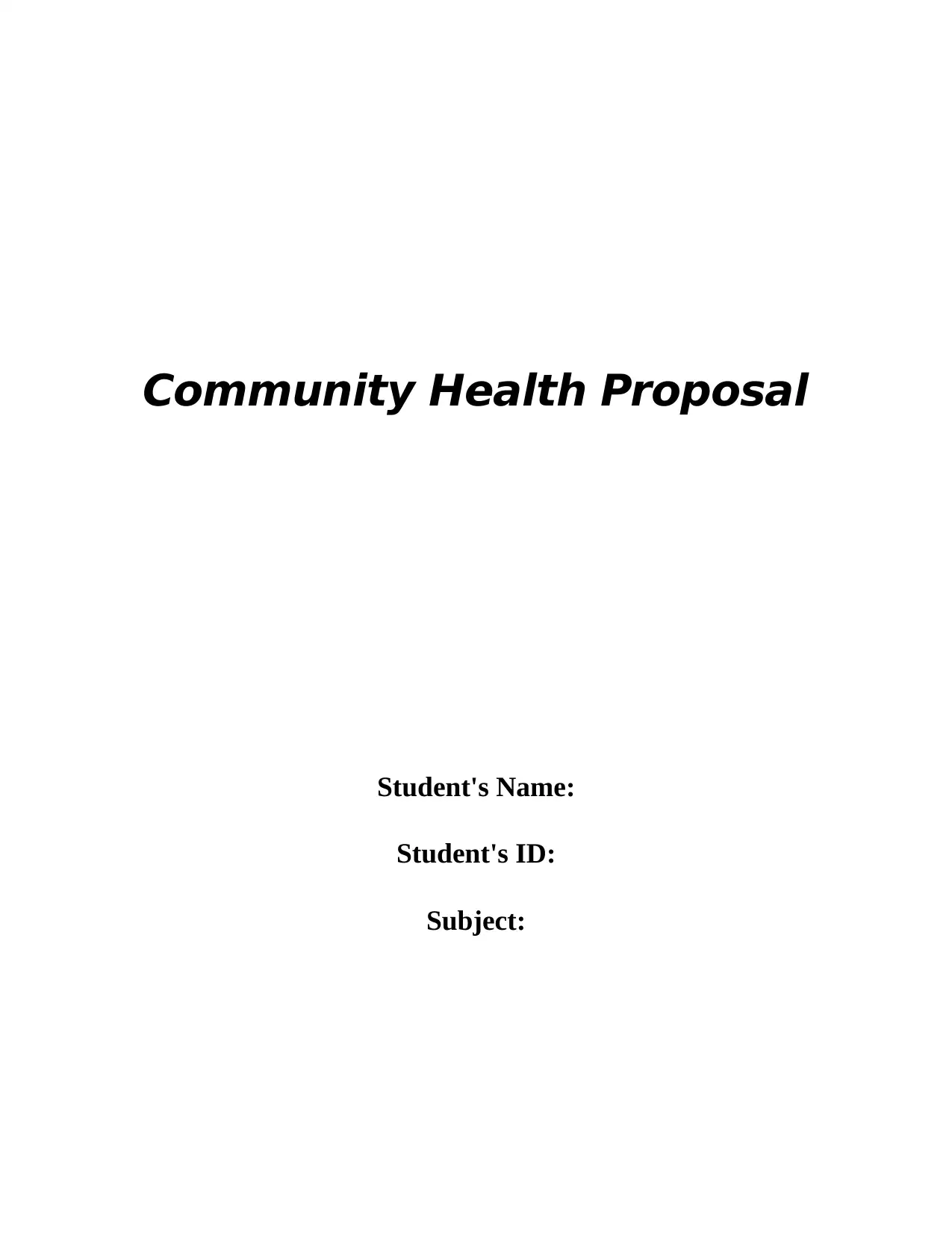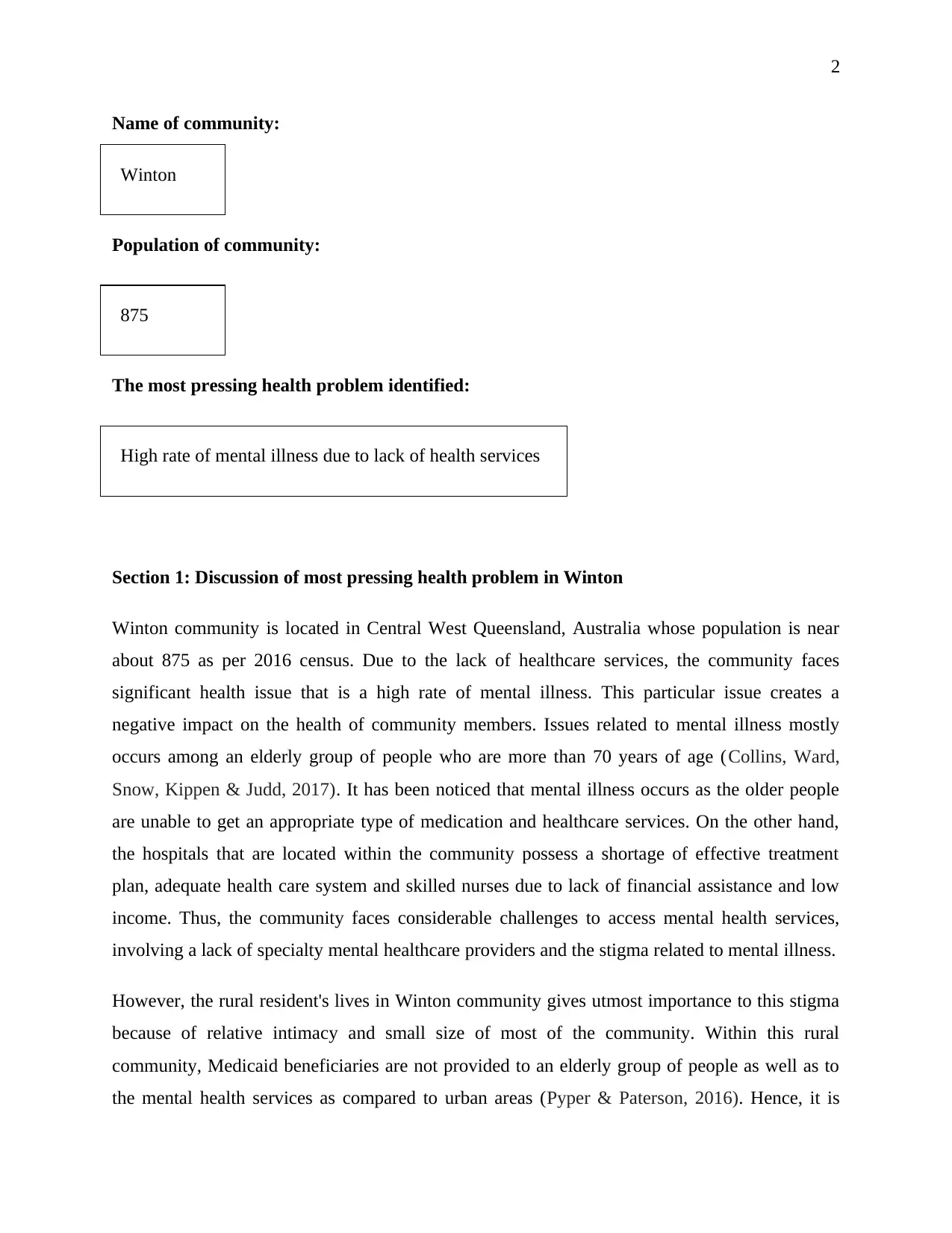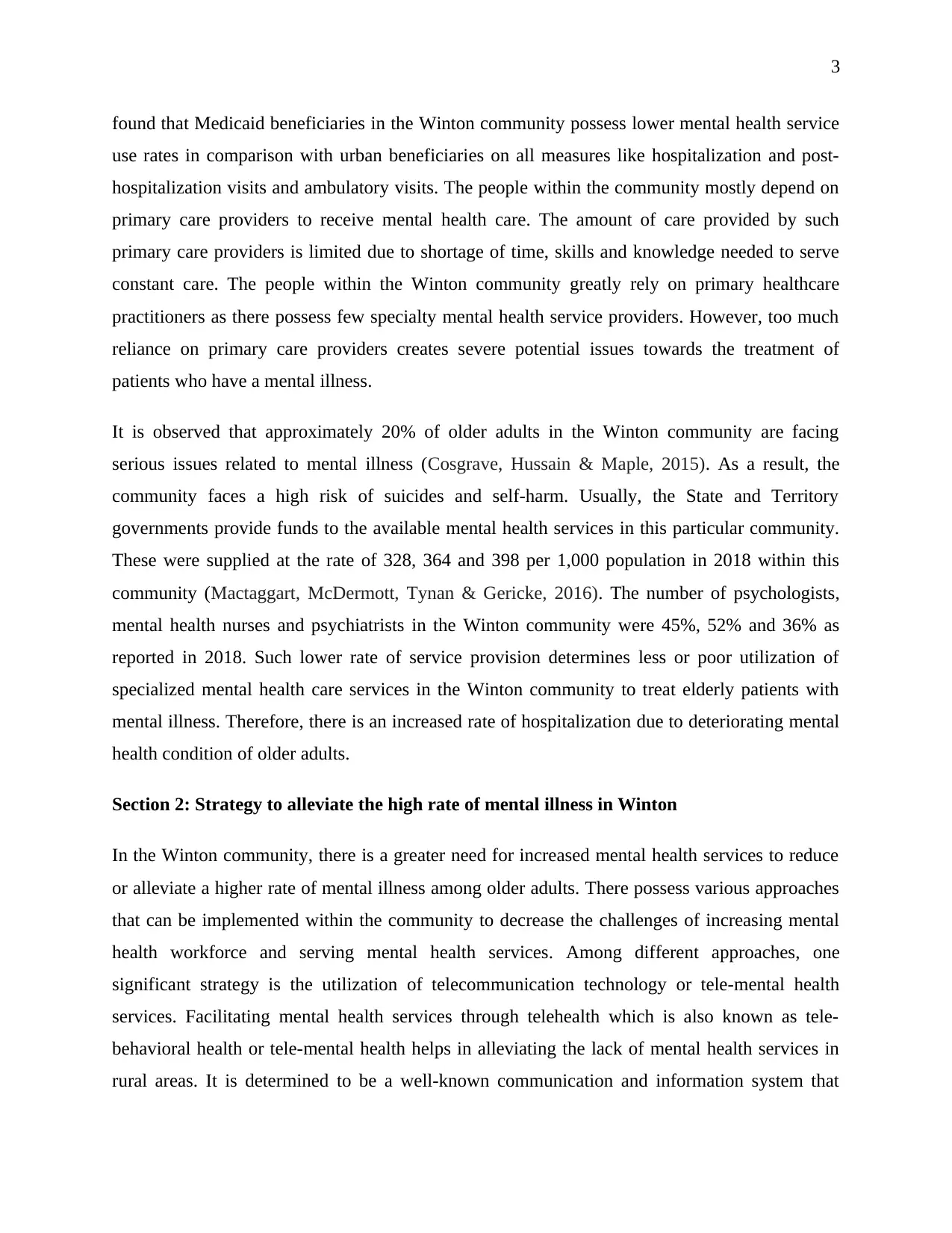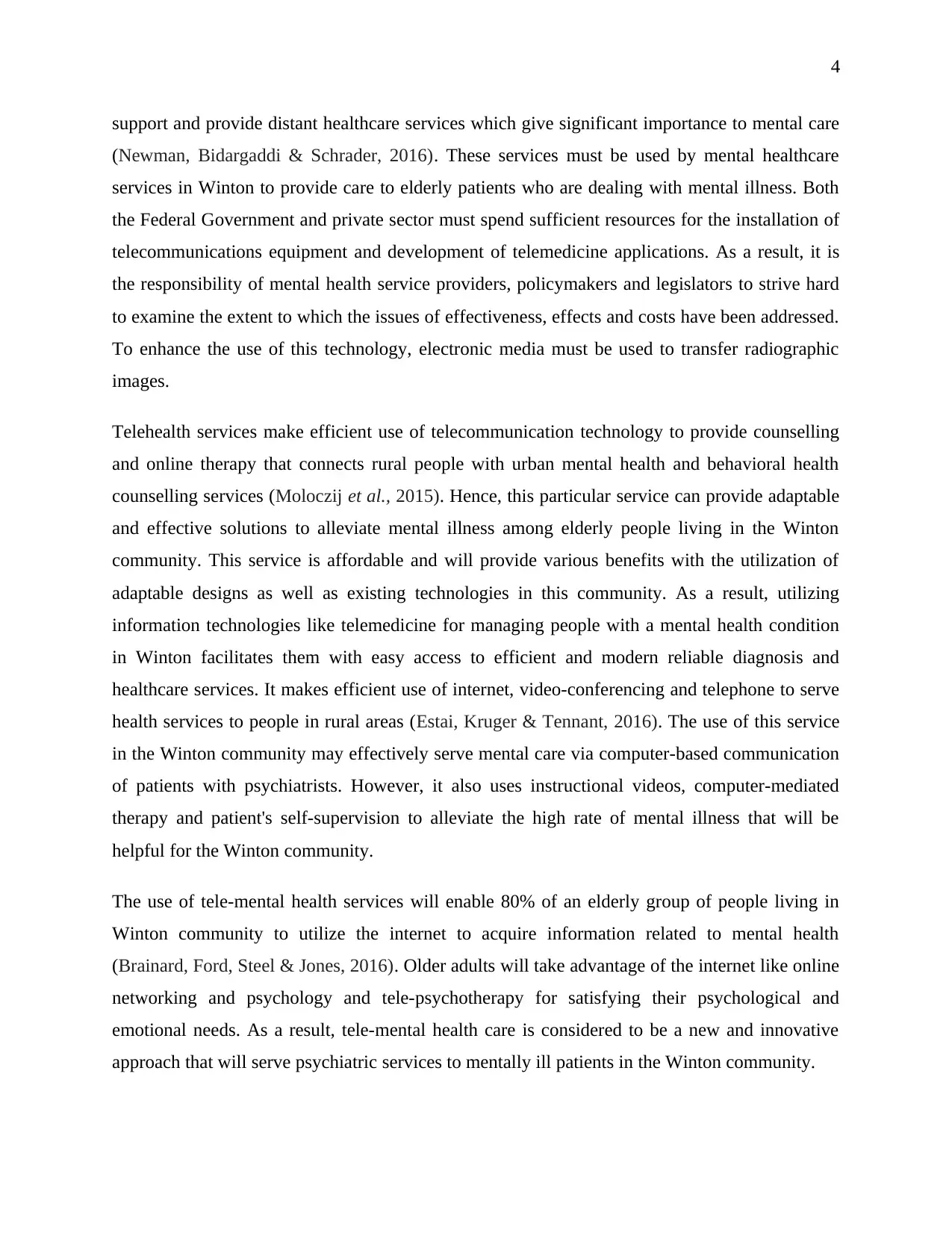Community Health Proposal: Addressing Mental Illness in Winton, QLD
VerifiedAdded on 2022/11/22
|6
|1587
|129
Report
AI Summary
This report presents a community health proposal focused on the Winton community in Central West Queensland, Australia, with a population of approximately 875 residents. The primary health concern identified is the high rate of mental illness, particularly among the elderly, attributed to a lack of healthcare services. The report discusses the challenges faced by the community, including a shortage of specialized mental healthcare providers, stigma associated with mental illness, and limited access to services due to financial constraints and a reliance on primary care providers. To address this issue, the proposal advocates for the utilization of telecommunication technology and tele-mental health services to alleviate the lack of mental health services in rural areas. The report emphasizes the potential benefits of telehealth, including improved access to counseling, online therapy, and efficient use of technology to provide modern reliable diagnosis and healthcare services, which will ultimately serve the community.

Community Health Proposal
Student's Name:
Student's ID:
Subject:
Student's Name:
Student's ID:
Subject:
Paraphrase This Document
Need a fresh take? Get an instant paraphrase of this document with our AI Paraphraser

1
Table of Contents
Section 1: Discussion of most pressing health problem in Winton.................................................2
Section 2: Strategy to alleviate the high rate of mental illness in Winton.......................................3
References........................................................................................................................................5
Table of Contents
Section 1: Discussion of most pressing health problem in Winton.................................................2
Section 2: Strategy to alleviate the high rate of mental illness in Winton.......................................3
References........................................................................................................................................5

2
Name of community:
Winton
Population of community:
875
The most pressing health problem identified:
High rate of mental illness due to lack of health services
Section 1: Discussion of most pressing health problem in Winton
Winton community is located in Central West Queensland, Australia whose population is near
about 875 as per 2016 census. Due to the lack of healthcare services, the community faces
significant health issue that is a high rate of mental illness. This particular issue creates a
negative impact on the health of community members. Issues related to mental illness mostly
occurs among an elderly group of people who are more than 70 years of age (Collins, Ward,
Snow, Kippen & Judd, 2017). It has been noticed that mental illness occurs as the older people
are unable to get an appropriate type of medication and healthcare services. On the other hand,
the hospitals that are located within the community possess a shortage of effective treatment
plan, adequate health care system and skilled nurses due to lack of financial assistance and low
income. Thus, the community faces considerable challenges to access mental health services,
involving a lack of specialty mental healthcare providers and the stigma related to mental illness.
However, the rural resident's lives in Winton community gives utmost importance to this stigma
because of relative intimacy and small size of most of the community. Within this rural
community, Medicaid beneficiaries are not provided to an elderly group of people as well as to
the mental health services as compared to urban areas (Pyper & Paterson, 2016). Hence, it is
Name of community:
Winton
Population of community:
875
The most pressing health problem identified:
High rate of mental illness due to lack of health services
Section 1: Discussion of most pressing health problem in Winton
Winton community is located in Central West Queensland, Australia whose population is near
about 875 as per 2016 census. Due to the lack of healthcare services, the community faces
significant health issue that is a high rate of mental illness. This particular issue creates a
negative impact on the health of community members. Issues related to mental illness mostly
occurs among an elderly group of people who are more than 70 years of age (Collins, Ward,
Snow, Kippen & Judd, 2017). It has been noticed that mental illness occurs as the older people
are unable to get an appropriate type of medication and healthcare services. On the other hand,
the hospitals that are located within the community possess a shortage of effective treatment
plan, adequate health care system and skilled nurses due to lack of financial assistance and low
income. Thus, the community faces considerable challenges to access mental health services,
involving a lack of specialty mental healthcare providers and the stigma related to mental illness.
However, the rural resident's lives in Winton community gives utmost importance to this stigma
because of relative intimacy and small size of most of the community. Within this rural
community, Medicaid beneficiaries are not provided to an elderly group of people as well as to
the mental health services as compared to urban areas (Pyper & Paterson, 2016). Hence, it is
⊘ This is a preview!⊘
Do you want full access?
Subscribe today to unlock all pages.

Trusted by 1+ million students worldwide

3
found that Medicaid beneficiaries in the Winton community possess lower mental health service
use rates in comparison with urban beneficiaries on all measures like hospitalization and post-
hospitalization visits and ambulatory visits. The people within the community mostly depend on
primary care providers to receive mental health care. The amount of care provided by such
primary care providers is limited due to shortage of time, skills and knowledge needed to serve
constant care. The people within the Winton community greatly rely on primary healthcare
practitioners as there possess few specialty mental health service providers. However, too much
reliance on primary care providers creates severe potential issues towards the treatment of
patients who have a mental illness.
It is observed that approximately 20% of older adults in the Winton community are facing
serious issues related to mental illness (Cosgrave, Hussain & Maple, 2015). As a result, the
community faces a high risk of suicides and self-harm. Usually, the State and Territory
governments provide funds to the available mental health services in this particular community.
These were supplied at the rate of 328, 364 and 398 per 1,000 population in 2018 within this
community (Mactaggart, McDermott, Tynan & Gericke, 2016). The number of psychologists,
mental health nurses and psychiatrists in the Winton community were 45%, 52% and 36% as
reported in 2018. Such lower rate of service provision determines less or poor utilization of
specialized mental health care services in the Winton community to treat elderly patients with
mental illness. Therefore, there is an increased rate of hospitalization due to deteriorating mental
health condition of older adults.
Section 2: Strategy to alleviate the high rate of mental illness in Winton
In the Winton community, there is a greater need for increased mental health services to reduce
or alleviate a higher rate of mental illness among older adults. There possess various approaches
that can be implemented within the community to decrease the challenges of increasing mental
health workforce and serving mental health services. Among different approaches, one
significant strategy is the utilization of telecommunication technology or tele-mental health
services. Facilitating mental health services through telehealth which is also known as tele-
behavioral health or tele-mental health helps in alleviating the lack of mental health services in
rural areas. It is determined to be a well-known communication and information system that
found that Medicaid beneficiaries in the Winton community possess lower mental health service
use rates in comparison with urban beneficiaries on all measures like hospitalization and post-
hospitalization visits and ambulatory visits. The people within the community mostly depend on
primary care providers to receive mental health care. The amount of care provided by such
primary care providers is limited due to shortage of time, skills and knowledge needed to serve
constant care. The people within the Winton community greatly rely on primary healthcare
practitioners as there possess few specialty mental health service providers. However, too much
reliance on primary care providers creates severe potential issues towards the treatment of
patients who have a mental illness.
It is observed that approximately 20% of older adults in the Winton community are facing
serious issues related to mental illness (Cosgrave, Hussain & Maple, 2015). As a result, the
community faces a high risk of suicides and self-harm. Usually, the State and Territory
governments provide funds to the available mental health services in this particular community.
These were supplied at the rate of 328, 364 and 398 per 1,000 population in 2018 within this
community (Mactaggart, McDermott, Tynan & Gericke, 2016). The number of psychologists,
mental health nurses and psychiatrists in the Winton community were 45%, 52% and 36% as
reported in 2018. Such lower rate of service provision determines less or poor utilization of
specialized mental health care services in the Winton community to treat elderly patients with
mental illness. Therefore, there is an increased rate of hospitalization due to deteriorating mental
health condition of older adults.
Section 2: Strategy to alleviate the high rate of mental illness in Winton
In the Winton community, there is a greater need for increased mental health services to reduce
or alleviate a higher rate of mental illness among older adults. There possess various approaches
that can be implemented within the community to decrease the challenges of increasing mental
health workforce and serving mental health services. Among different approaches, one
significant strategy is the utilization of telecommunication technology or tele-mental health
services. Facilitating mental health services through telehealth which is also known as tele-
behavioral health or tele-mental health helps in alleviating the lack of mental health services in
rural areas. It is determined to be a well-known communication and information system that
Paraphrase This Document
Need a fresh take? Get an instant paraphrase of this document with our AI Paraphraser

4
support and provide distant healthcare services which give significant importance to mental care
(Newman, Bidargaddi & Schrader, 2016). These services must be used by mental healthcare
services in Winton to provide care to elderly patients who are dealing with mental illness. Both
the Federal Government and private sector must spend sufficient resources for the installation of
telecommunications equipment and development of telemedicine applications. As a result, it is
the responsibility of mental health service providers, policymakers and legislators to strive hard
to examine the extent to which the issues of effectiveness, effects and costs have been addressed.
To enhance the use of this technology, electronic media must be used to transfer radiographic
images.
Telehealth services make efficient use of telecommunication technology to provide counselling
and online therapy that connects rural people with urban mental health and behavioral health
counselling services (Moloczij et al., 2015). Hence, this particular service can provide adaptable
and effective solutions to alleviate mental illness among elderly people living in the Winton
community. This service is affordable and will provide various benefits with the utilization of
adaptable designs as well as existing technologies in this community. As a result, utilizing
information technologies like telemedicine for managing people with a mental health condition
in Winton facilitates them with easy access to efficient and modern reliable diagnosis and
healthcare services. It makes efficient use of internet, video-conferencing and telephone to serve
health services to people in rural areas (Estai, Kruger & Tennant, 2016). The use of this service
in the Winton community may effectively serve mental care via computer-based communication
of patients with psychiatrists. However, it also uses instructional videos, computer-mediated
therapy and patient's self-supervision to alleviate the high rate of mental illness that will be
helpful for the Winton community.
The use of tele-mental health services will enable 80% of an elderly group of people living in
Winton community to utilize the internet to acquire information related to mental health
(Brainard, Ford, Steel & Jones, 2016). Older adults will take advantage of the internet like online
networking and psychology and tele-psychotherapy for satisfying their psychological and
emotional needs. As a result, tele-mental health care is considered to be a new and innovative
approach that will serve psychiatric services to mentally ill patients in the Winton community.
support and provide distant healthcare services which give significant importance to mental care
(Newman, Bidargaddi & Schrader, 2016). These services must be used by mental healthcare
services in Winton to provide care to elderly patients who are dealing with mental illness. Both
the Federal Government and private sector must spend sufficient resources for the installation of
telecommunications equipment and development of telemedicine applications. As a result, it is
the responsibility of mental health service providers, policymakers and legislators to strive hard
to examine the extent to which the issues of effectiveness, effects and costs have been addressed.
To enhance the use of this technology, electronic media must be used to transfer radiographic
images.
Telehealth services make efficient use of telecommunication technology to provide counselling
and online therapy that connects rural people with urban mental health and behavioral health
counselling services (Moloczij et al., 2015). Hence, this particular service can provide adaptable
and effective solutions to alleviate mental illness among elderly people living in the Winton
community. This service is affordable and will provide various benefits with the utilization of
adaptable designs as well as existing technologies in this community. As a result, utilizing
information technologies like telemedicine for managing people with a mental health condition
in Winton facilitates them with easy access to efficient and modern reliable diagnosis and
healthcare services. It makes efficient use of internet, video-conferencing and telephone to serve
health services to people in rural areas (Estai, Kruger & Tennant, 2016). The use of this service
in the Winton community may effectively serve mental care via computer-based communication
of patients with psychiatrists. However, it also uses instructional videos, computer-mediated
therapy and patient's self-supervision to alleviate the high rate of mental illness that will be
helpful for the Winton community.
The use of tele-mental health services will enable 80% of an elderly group of people living in
Winton community to utilize the internet to acquire information related to mental health
(Brainard, Ford, Steel & Jones, 2016). Older adults will take advantage of the internet like online
networking and psychology and tele-psychotherapy for satisfying their psychological and
emotional needs. As a result, tele-mental health care is considered to be a new and innovative
approach that will serve psychiatric services to mentally ill patients in the Winton community.

5
References
Brainard, J. S., Ford, J. A., Steel, N., & Jones, A. P. (2016). A systematic review of health
service interventions to reduce use of unplanned health care in rural areas. Journal of
evaluation in clinical practice, 22(2), 145-155.
Collins, J., Ward, B. M., Snow, P., Kippen, S., & Judd, F. (2017). Compositional, contextual,
and collective community factors in mental health and well-being in Australian rural
communities. Qualitative health research, 27(5), 677-687.
Cosgrave, C., Hussain, R., & Maple, M. (2015). Factors impacting on retention amongst
community mental health clinicians working in rural Australia: A literature
review. Advances in Mental Health, 13(1), 58-71.
Estai, M., Kruger, E., & Tennant, M. (2016). Role of telemedicine and mid‐level dental
providers in expanding dental‐care access: potential application in rural
Australia. International dental journal, 66(4), 195-200.
Mactaggart, F., McDermott, L., Tynan, A., & Gericke, C. (2016). Examining health and well‐
being outcomes associated with mining activity in rural communities of high‐income
countries: A systematic review. Australian Journal of Rural Health, 24(4), 230-237.
Moloczij, N., Mosley, I., Moss, K. M., Bagot, K. L., Bladin, C. F., & Cadilhac, D. A. (2015). Is
telemedicine helping or hindering the delivery of stroke thrombolysis in rural areas? A
qualitative analysis. Internal medicine journal, 45(9), 957-964.
Newman, L., Bidargaddi, N., & Schrader, G. (2016). Service providers’ experiences of using a
telehealth network 12 months after digitisation of a large Australian rural mental health
service. International journal of medical informatics, 94, 8-20.
Pyper, Z., & Paterson, J. L. (2016). Fatigue and mental health in Australian rural and regional
ambulance personnel. Emergency Medicine Australasia, 28(1), 62-66.
References
Brainard, J. S., Ford, J. A., Steel, N., & Jones, A. P. (2016). A systematic review of health
service interventions to reduce use of unplanned health care in rural areas. Journal of
evaluation in clinical practice, 22(2), 145-155.
Collins, J., Ward, B. M., Snow, P., Kippen, S., & Judd, F. (2017). Compositional, contextual,
and collective community factors in mental health and well-being in Australian rural
communities. Qualitative health research, 27(5), 677-687.
Cosgrave, C., Hussain, R., & Maple, M. (2015). Factors impacting on retention amongst
community mental health clinicians working in rural Australia: A literature
review. Advances in Mental Health, 13(1), 58-71.
Estai, M., Kruger, E., & Tennant, M. (2016). Role of telemedicine and mid‐level dental
providers in expanding dental‐care access: potential application in rural
Australia. International dental journal, 66(4), 195-200.
Mactaggart, F., McDermott, L., Tynan, A., & Gericke, C. (2016). Examining health and well‐
being outcomes associated with mining activity in rural communities of high‐income
countries: A systematic review. Australian Journal of Rural Health, 24(4), 230-237.
Moloczij, N., Mosley, I., Moss, K. M., Bagot, K. L., Bladin, C. F., & Cadilhac, D. A. (2015). Is
telemedicine helping or hindering the delivery of stroke thrombolysis in rural areas? A
qualitative analysis. Internal medicine journal, 45(9), 957-964.
Newman, L., Bidargaddi, N., & Schrader, G. (2016). Service providers’ experiences of using a
telehealth network 12 months after digitisation of a large Australian rural mental health
service. International journal of medical informatics, 94, 8-20.
Pyper, Z., & Paterson, J. L. (2016). Fatigue and mental health in Australian rural and regional
ambulance personnel. Emergency Medicine Australasia, 28(1), 62-66.
⊘ This is a preview!⊘
Do you want full access?
Subscribe today to unlock all pages.

Trusted by 1+ million students worldwide
1 out of 6
Related Documents
Your All-in-One AI-Powered Toolkit for Academic Success.
+13062052269
info@desklib.com
Available 24*7 on WhatsApp / Email
![[object Object]](/_next/static/media/star-bottom.7253800d.svg)
Unlock your academic potential
Copyright © 2020–2025 A2Z Services. All Rights Reserved. Developed and managed by ZUCOL.





